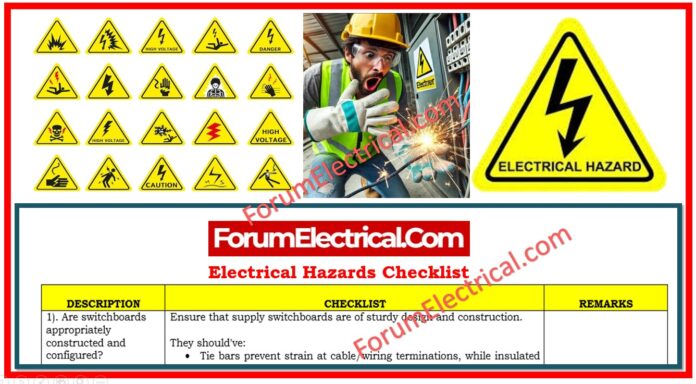The purpose of this checklist is to give a comprehensive guide for assessing the electrical safety guaranteeing compliance with regulations, and ensuring the safe operation of electrical systems, tools, & equipment.
1). Are Switchboards Appropriately Constructed and Configured?
Checklist:
Check to see that the switchboards that are used for supply are of solid construction and design.
It is imperative that the following be present:
- To prevent tension at the terminations of cables and wiring, tie bars are used.
- Supports that are insulated and allow cables & extension leads to be supported.
- In order to prevent damage to leads, a door that can be locked.
- On the occasion of carrying out electrical work, a way that guarantees the door will remain open.
- When positioned outside or in regions that are vulnerable to water, weatherproofing is necessary.
- A clean area that is at least one meter in front of the switchboard should be maintained at all times.
- An enclosure that can be locked for circuit breakers, with the exception of main (or) isolating switches.
- The meter panels & fuse assemblies are both permitted for use with this locking device.
Remarks: Accidents can be avoided and longevity in difficult conditions can be ensured via proper implementation of construction.
2) Is there protection against earth leakage for all of the circuits, electrical plant, portable equipment, & tools?
Checklist:
It is imperative that you ensure that all of the final sub-circuits, electrical plant, portable electrical equipment, & tools are protected against earth leakage faults in order to avoid incidents of electrical shock.
Remarks: In order to ensure the safety of workers, earth leakage protection is absolutely necessary.
3). Are the General-Purpose Outlets That Are Appropriate Being Used?
Checklist:
Verify that the 240V sockets on portable devices are linked to the general-purpose outlets that are equipped with double-pole switches.
Remarks: It is important to note that this guarantees that the equipment is properly isolated whenever it is required.
4). Are the Portable Outlets Appropriate for the Situation?
Checklist:
- Under no circumstances should building sites make use of double adapters.
- Make sure that portable multi-plug outlets that have several plug sockets are being used during the process.
Remarks: In order to prevent overloading, only outlets that have been approved should be utilized.
5). Are instruments that are powered by electricity & flexible leads safe to use?
Checklist:
- When an electrician arrives at the location, as well as at regular intervals after that, make sure that all of the electrically powered tools & flexible leads are inspected, tested, & tagged by the electrician.
- An inspection log should be kept.
- As soon as possible, remove from service any tools or leads that are not functioning properly until they are either fixed or replaced.
Remarks: The use of broken instruments is prevented by performing routine inspections, which in turn reduces the likelihood of injury.
6). What is the status of the electrical compliance certificates that have been provided?
Checklist:
Before utilizing any building wire, including switchboards, it is important to make certain that Electrical Certificates of Compliance have been given.
Remarks: Compliance certifications serve as evidence that the installation satisfies the required safety standards.
7). Are there Any Tests Conducted on Earth Leaks?
Checklist:
- Make sure that earth leakage devices are tested prior to each usage by clicking the test button throughout the testing process.
- Every month, an electrician should do a test to determine the tripping current and time.
Remarks: It is important to note that routine testing guarantees that earth leakage prevention is operating correctly.
8). Are Portable Generators an Appropriate Measure to Take?
Checklist:
- Make certain that portable generators are in good working order and have been properly maintained.
- Ensure that generators are fitted with an earth leakage device that has a capacity of 30 milliamperes (30mA).
- Make sure that generators that feed a fixed installation are installed by a certified electrical contractor, and that an Electrical Certificate of Compliance is issued.
- Make certain that the earth and bonding connections have been installed in accordance with the specifications provided by the manufacturer.
Remarks: It is important to note that safe generator running is dependent on proper maintenance and compliance.
9). Will the Leads Be Laid Out in a Secure Method?
Checklist:
- Make certain that electrical leads are not positioned in areas where they might cause harm or where they could create a tripping hazard, such as under water or in mud.
- When it is required to maintain leads high, lead stands should be utilized.
- Through the utilization of S-shaped off-cuts of steel that are coated in garden hose, it is possible to prevent leads from being wrapped around scaffolding or formwork.
Remarks: It should be noted that effective lead management reduces the risk of damage & trip hazards.
10). Are there any plants or Temporary structures that are far enough away from the Power Lines to be considered safe?
Checklist:
Ensure that “no go zone” safe clearances are adhered to in order to keep proper distances between live power lines and cranes, high platforms, earth-moving equipment, scaffolding, formwork, & ladders.
Remarks: Safe distances prohibit people from coming into contact with live electrical equipment, which helps to prevent accidents from happening.
11). Does the Work of Installing and Repairing Electrical Equipment take place in a Safe Manner?
Checklist:
Make sure that all electrical installation and maintenance work is carried out under the supervision of electricians who have been verified as professionals.
Remarks: During electrical work, having the appropriate supervision assures both safety and compliance with regulations.
The purpose of this checklist is to act as a thorough reference for ensuring the safety and dependability of electrical systems. Its purpose is to assist in the prevention of accidents and to assure compliance with safety requirements.









